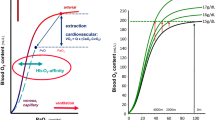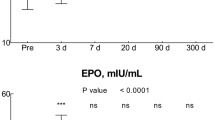Abstract
Recent publications reflect the anti-doping authorities’ concern about the use of altitude simulator systems as violating the spirit of sport criterion (Levine 2006; Loland and Murray 2007; Spriggs 2005). The aim of our study was to determine whether intermittent hypoxic treatments could modify the hemoglobin, hematocrit, reticulocytes, and erythropoietic stimulation index (OFF-Hr Score) values after administration of rHuEPO-alpha. Although these hematological parameters are of secondary nature some international sport federations currently exclude athletes who show aberrant values of these parameters from competition. Ten young male Wistar rats were treated, three times a week for 2 weeks, with 500 IU of rHuEPO-alpha. After the treatment, the animals were randomly divided into two groups: normoxic and hypoxic. The normoxic group was maintained at 21% O2 24 h a day for 23 days. The hypoxic group was maintained 12 h at 21% O2 and 12 h at 12% O2 (~4,000 m) the same time period. After the rHuEPO-alpha treatment, the hypoxic group of animals had a faster recovery rate in the reticulocyte count, elevated concentrations of hemoglobin and hematocrit and a significant increase in the endogenous EPO levels when compared with the normoxic group of animals. These changes led to significant modifications in the OFF-Hr Score between the hypoxic and normoxic animals. Intermittent hypoxic treatments after rHuEPO administration can significantly modify the main hematological parameters tested by the anti-doping authorities. Our results in an animal model suggest checking the described phenomena in humans in order to reach major conclusions.





Similar content being viewed by others
References
Abbrecht PH, Littell JK (1972) Plasma erythropoietin in men and mice during acclimatization to different altitudes. J Appl Physiol 32:54–58
Beullens M, Delanghe JR, Bollen M (2006) False-positive detection of recombinant human erythropoietin in urine following strenuous physical exercise. Blood 107:4711–4713
Bonetti DL, Hopkins WG, Kilding AE (2006) High-intensity kayak performance after adaptation to intermittent hypoxia. Int J Sports Physiol Perform 1:246–260
Calbet JA, Lundby C, Koskolou M, Boushel R (2006) Importance of hemoglobin concentration to exercise: acute manipulations. Respir Physiol Neurobiol 151:132–140
Damsgaard R, Munch T, Morkeberg J, Mortensen SP, Gonzalez-Alonso J (2006) Effects of blood withdrawal and reinfusion on biomarkers of erythropoiesis in humans: Implications for anti-doping strategies. Haematologica 91:1006–1008
Delanghe JR, Bollen M, Beullens M (2008) Testing for recombinant erythropoietin. Am J Hematol 83:237–241
Ebert BL, Bunn HF (1999) Regulation of the erythropoietin gene. Blood 94:1864–1877
Gonzalez NC, Clancy RL, Wagner PD (1993) Determinants of maximal oxygen uptake in rats acclimated to simulated altitude. J Appl Physiol 75:1608–1614
Gonzalez NC, Erwig LP, Painter CF 3rd, Clancy RL, Wagner PD (1994) Effect of hematocrit on systemic O2 transport in hypoxic and normoxic exercise in rats. J Appl Physiol 77:1341–1348
Gore CJ, Parisotto R, Ashenden MJ, Stray-Gundersen J, Sharpe K, Hopkins W, Emslie KR, Howe C, Trout GJ, Kazlauskas R, Hahn AG (2003) Second-generation blood tests to detect erythropoietin abuse by athletes. Haematologica 88:333–344
Julian CG, Gore CJ, Wilber RL, Daniels JT, Fredericson M, Stray-Gundersen J, Hahn AG, Parisotto R, Levine BD (2004) Intermittent normobaric hypoxia does not alter performance or erythropoietic markers in highly trained distance runners. J Appl Physiol 96:1800–1807
Laitinen H, Alopaeus K, Heikkinen R, Hietanen H, Mikkelsson L, Tikkanen HO, Rusko HK (1995) Acclimatization to living in normobaric hypoxia and training in normoxia at sea level in runners (Abstract). Med Sci Sports Exerc 27:S617
Lasne F, de Ceaurriz J (2000) Recombinant erythropoietin in urine. Nature 405:635
Lasne F, Martin L, Crepin N, de Ceaurriz J (2002) Detection of isoelectric profiles of erythropoietin in urine: differentiation of natural and administered recombinant hormones. Anal Biochem 311:119–126
Levine BD (2006) Should “artificial” high altitude environments be considered doping? Scand J Med Sci Sports 16:297–301
Levine BD, Stray-Gundersen J (1997) “Living high-training low”: effect of moderate-altitude acclimatization with low-altitude training on performance. J Appl Physiol 83:102–112
Levine BD, Stray-Gundersen J (2005) Point: positive effects of intermittent hypoxia (live high:train low) on exercise performance are mediated primarily by augmented red cell volume. J Appl Physiol 99:2053–2055
Lippi G, Franchini M, Guidi GC (2007) Prohibition of artificial hypoxic environments in sports: health risks rather than ethics. Appl Physiol Nutr Metab 32:1206–1207 discussion 1208–1209
Loland S, Murray TH (2007) The ethics of the use of technologically constructed high-altitude environments to enhance performances in sport. Scand J Med Sci Sports 17:193–195
Lundby C, Thomsen JJ, Boushel R, Koskolou M, Warberg J, Calbet JA, Robach P (2007) Erythropoietin treatment elevates haemoglobin concentration by increasing red cell volume and depressing plasma volume. J Physiol 578:309–314
Lundby C, Achman-Andersen NJ, Thomsen JJ, Norgaard AM, Robach P (2008) Testing for recombinant human erythropoietin in urine: problems associated with current anti-doping testing. J Appl Physiol 105:417–419
Malloy DC, Kell R, Kelln R (2007) The spirit of sport, morality, and hypoxic tents: logic and authenticity. Appl Physiol Nutr Metab 32:289–296
Neya M, Enoki T, Kumai Y, Sugoh T, Kawahara T (2007) The effects of nightly normobaric hypoxia and high intensity training under intermittent normobaric hypoxia on running economy and hemoglobin mass. J Appl Physiol 103:828–834
Nummela A, Rusko H (2000) Acclimatization to altitude and normoxic training improve 400-m running performance at sea level. J Sports Sci 18:411–419
Parisotto R, Gore CJ, Emslie KR, Ashenden MJ, Brugnara C, Howe C, Martin DT, Trout GJ, Hahn AG (2000) A novel method utilising markers of altered erythropoiesis for the detection of recombinant human erythropoietin abuse in athletes. Haematologica 85:564–572
Parisotto R, Wu M, Ashenden MJ, Emslie KR, Gore CJ, Howe C, Kazlauskas R, Sharpe K, Trout GJ, Xie M (2001) Detection of recombinant human erythropoietin abuse in athletes utilizing markers of altered erythropoiesis. Haematologica 86:128–137
Parisotto R, Ashenden MJ, Gore CJ, Sharpe K, Hopkins W, Hahn AG (2003) The effect of common hematologic abnormalities on the ability of blood models to detect erythropoietin abuse by athletes. Haematologica 88:931–940
Reboul C, Tanguy S, Dauzat M, Obert P (2005) Altitude negates the benefits of aerobic training on the vascular adaptations in rats. Med Sci Sports Exerc 37:979–985
Robach P, Calbet JA, Thomsen JJ, Boushel R, Mollard P, Rasmussen P, Lundby C (2008) The ergogenic effect of recombinant human erythropoietin on VO2max depends on the severity of arterial hypoxemia. PLoS ONE 3:e2996
Robinson N, Giraud S, Saudan C, Baume N, Avois L, Mangin P, Saugy M (2006) Erythropoietin and blood doping. Br J Sports Med 40(Suppl 1):i30–i34
Roels B, Millet GP, Marcoux CJ, Coste O, Bentley DJ, Candau RB (2005) Effects of hypoxic interval training on cycling performance. Med Sci Sports Exerc 37:138–146
Rusko HK, Tikkanen H, Paavolainen L, Hamalainen I, Kalliokoski KAP (1999) Effect of living in hypoxia and training in normoxia on sea level VO2 max and red cell mass (Abstract). Med Sci Sports Exerc 31:S86
Semenza GL, Wang GL (1992) A nuclear factor induced by hypoxia via de novo protein synthesis binds to the human erythropoietin gene enhancer at a site required for transcriptional activation. Mol Cell Biol 12:5447–5454
Sharpe K, Hopkins W, Emslie KR, Howe C, Trout GJ, Kazlauskas R, Ashenden MJ, Gore CJ, Parisotto R, Hahn AG (2002) Development of reference ranges in elite athletes for markers of altered erythropoiesis. Haematologica 87:1248–1257
Sharpe K, Ashenden MJ, Schumacher YO (2006) A third generation approach to detect erythropoietin abuse in athletes. Haematologica 91:356–363
Souillard A, Audran M, Bressolle F, Gareau R, Duvallet A, Chanal JL (1996) Pharmacokinetics and pharmacodynamics of recombinant human erythropoietin in athletes. Blood sampling and doping control. Br J Clin Pharmacol 42:355–364
Spriggs M (2005) Hypoxic air machines: performance enhancement through effective training—or cheating? J Med Ethics 31:112–113
Truijens MJ, Toussaint HM, Dow J, Levine BD (2003) Effect of high-intensity hypoxic training on sea-level swimming performances. J Appl Physiol 94:733–743
Wide L, Bengtsson C (1990) Molecular charge heterogeneity of human serum erythropoietin. Br J Haematol 76:121–127
Wilber RL (2007a) Application of altitude/hypoxic training by elite athletes. Med Sci Sports Exerc 39:1610–1624
Wilber RL (2007b) Introduction to altitude/hypoxic training symposium. Med Sci Sports Exerc 39:1587–1589
Wilber RL, Stray-Gundersen J, Levine BD (2007) Effect of hypoxic “dose” on physiological responses and sea-level performance. Med Sci Sports Exerc 39:1590–1599
Acknowledgments
We thank Mrs Marilyn Noyes for her kind help in reviewing the manuscript and to Mr Daniel Martinez Bello for his help in the Statistical Analysis. The authors’ work was supported by grants DPS2008-06968 and BFU2007-65 803/BFI to J. V.; 24/UPB20/07 and 35/UPB20/08 to M. C. G-C and by grant (ISCIII2006-RED13-027) from the “Red Temática de investigación cooperativa en envejecimiento y fragilidad (RETICEF). Instituto de Salud Carlos III”.
Conflict of interest statement
None of the authors had any conflicts of interest with the funding agencies or professional relationships with companies or manufacturers who may benefit from the results of the present study.
Author information
Authors and Affiliations
Corresponding author
Electronic supplementary material
Below is the link to the electronic supplementary material.
Rights and permissions
About this article
Cite this article
Sanchis-Gomar, F., Martinez-Bello, V.E., Domenech, E. et al. Effect of intermittent hypoxia on hematological parameters after recombinant human erythropoietin administration. Eur J Appl Physiol 107, 429–436 (2009). https://doi.org/10.1007/s00421-009-1141-3
Accepted:
Published:
Issue Date:
DOI: https://doi.org/10.1007/s00421-009-1141-3




